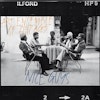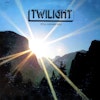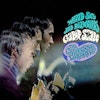There are three very distinct and equally bracing periods in the long history of the Art Ensemble of Chicago of which the album Nice Guys winningly represents the second. Born of the struggle for social justice and Black rights empowerment in 1966 in Chicago, the mesmerizing freer-than-free outfit had more up their sleeves than jazz from their start.
The core group—avant-garde saxophonist-composer Roscoe Mitchell, fellow saxman Joseph Jarman, bassist Malachi Favors, and trumpeter Lester Bowie—came out of the Roscoe Mitchell Sextet and the original Art Ensemble—itself an offshoot of Chicago pianist Muhal Richard Abrams’s Experimental Band of the early 1960s. Abrams was a cofounder of Chicago’s Association for the Advancement of Creative Musicians (a Black-owned non-profit that supported jazz and its players), in which the Ensemble’s core were early members and steeped in the era’s ethos of self-determination and the avant-garde. The foursome performed in different variations of the group—and the timeline is muddy and oft-argued—until they finally all linked together for the first time on Bowie’s 1967 recording, Numbers 1 & 2, for the Nessa label.
Then the foursome welcomed another AACM member, percussionist Famoudou Don Moye (whose African instruments and mindful philosophy made up his Sun Percussion practice), to the fold, and the die was cast, and their first branded aesthetic became clear—one that embraced the manners of European art music and the intuition of indigenous African folk with free jazz, church music, and the vaudeville songs of their youth. To complete the Chi-Town Ensemble’s picture and its motto of all things, “Ancient to the Future,” each member adopted his own face-paint and radical costume style to highlight their personalities embodied by its raucous post-post-post-avant-bop.
A klatch of raw-knuckled classics such as Message to Our Folks, Live in Paris, Eda Wobu, and A Jackson in Your House (all recorded in 1969!); With Fontella Bass and Certain Blacks (both 1970), up through 1973’s apt-titled likes Fanfare for the Warriors and Chi-Congo—all on small, independent labels—proved their motto and showed off the Art Ensemble’s mission of pulling the vexing, vibrant multi-sounds of the past screaming into the future.
Then there’s the ECM period that starts with Nice Guys, an epic that culls all of the disperse and diverse wild hairs of the Art Ensemble’s totality, marries that with who they had become—collectively, individually, theatrically, and savvily—as improvisers and composers, and breathed into the group the cool, distanced air that only Manfred Eicher’s label could bring, without the AEoC’s heat and clutter.
Engineered by oxygen-ated ECM favorite Martin Wieland (Ralph Towner, Keith Jarrett, Eberhard Weber) and produced by Eicher in May of 1978 at the spacious Bauer studios in Ludwigsburg, Germany, Nice Guys was the first Art Ensemble of Chicago album released after a five-year recording break.
It would be wrong to state that Nice Guys is the sound of restraint or a toning-down of the Ensemble’s restless sound or a smoothing over of its raw silken edges. What it is, however, is a naturally aged refinement of their bawdy brand with enough literal roominess given to each in-between so to allow its showy, Africa-meets-Chicago tone to come through more clearly, maintain its jittery, jokey vibe, and add in newer elements such as Bowie’s homebound love of St. Louis blues (portrayed often as an elephant’s bray, a wailing, silvery tone that would become his signature going forward, especially in his solo Brass Fantasy group), a little reggae for flavor, and more space than ever before.
Such space gives the six elegant art music suites that make up Nice Guys—two apiece from Mitchell and Jarman, one each from Bowie and Moye—a unified sonic spirit (something their rough-hewn previous albums rarely embraced) while allowing each man’s newly developed compositional chops to shine through beautifully. Moye’s murky, funky “Folkus” doesn’t sound like Mitchell’s icy, free “Cyp” or Bowie’s jaunty, wonky “Ja.” Yet, they fit each other’s groove and spirit like a perfectly pieced-together puzzle kit.
Lest you believe that all of Eicher-Wieland’s cushioned roominess would lend Nice Guys too much empty ambience, check into Bowie’s use of the celeste (to heighten their Euro-Art sensibilities) and Moye’s mass of bells, car horns, chimes, conch shells, timpani, human whistles, and, of course, Sun Percussion. The tickling nuances and bugged-out noise that made the Art Ensemble tingle and click are here in full effect, but given their own special shine rather than be allowed to get lost in a muddy mix.
All of this brings the listener to Jarman’s tonic finale, “Dreaming of the Master.” Dedicated not so much to their ancient African past, but rather a contemporary such as Miles Davis (of whom Lester Bowie is his most brilliant competition for inventive trumpeter stakes), the nearly twelve-minute minuet borrows liberally from Davis’s mid-’60s quintet with its jittery elegance intact. And yet, “Dreaming of the Master” is a tribute and testament to the power of who the Art Ensemble had been before, and who they would become on Nice Guys: something wild, something wise, and definitely nice and like no other.



